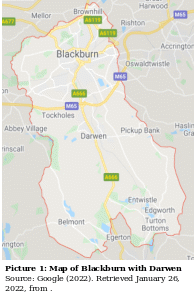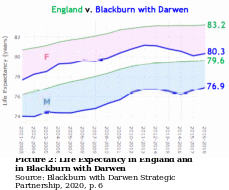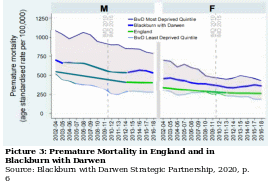Executive Summary
Blackburn with Darwen is one of the most deprived areas in the UK, with a significant share of unemployed people and those who did not receive a degree or, at least, qualification. Lower life expectancy and higher infant mortality rates are also inherent to this borough. The general cause of the boroughs underdevelopment lies in the over-compensation of economically profitable areas and cities, such as London. The present paper analyses the academic literature on geographic inequality and secondary sources data on how uneven development manifests itself in Blackburn with Darwen. The paper also contains methodological suggestions for further research of Blackburn with Darwens poor socioeconomic development.
Introduction
The notion of uneven development refers to the uneven economic development across the country. This unevenness could be noted in income and employment disparities between the citizens living in different country regions. One could suggest that this feature is exclusively inherent to less economically developed countries. Indeed, in the majority of developing nations of Africa and Asia, there are substantial disparities between the quality of life living in the capitals and remote areas. However, it should be noted that the same problem of uneven development could be observed in the UK even though it is an economically developed country. The present report examines the issue of the UK’s uneven development on the example of such a unitary authority area as Blackburn with Darwen. The report aims to analyze this region and investigate the causes of the disparity. The paper contains a literature review on the topic of geographic inequality, a baseline analysis of Blackburn with Darwen, and methodological suggestions for the further research of uneven development of the UK.
Literature Review
The notion of geographic inequality refers to differences in living standards between the population of different areas. These differences manifest themselves in social inequality, income inequality, and healthcare inequality (Lewer et al., 2020; Manduca, 2019; Yourkavitch et al., 2018). This problem is topical only for the underdeveloped nations of Asia and Africa but for such world-leading countries as the UK and the US (Lewer et al., 2020; Clark & Doussard, 2019). There is no common view on the reasons for the formation of geographic inequality and uneven development in the academic community.
Scholars mainly claim that uneven development results from capitalism and neo-liberalism. According to MacKinnon and Cumbers (2018), Yeung (2019), and Latham (2018), capitalism is the major cause of geographical unevenness. More precisely, in capitalist societies, investments and growth are usually concentrated in one area that is better than others due to its geographic location, resources, and capital (MacKinnon & Cumbers, 2018). When the development and economic growth starts in this area, “it tends to ‘suck in’ investment, labour and resources from surrounding regions” (MacKinnon & Cumbers, 2018, p. 10). What is more, this unevenness is further enhanced by the variety of social, political, and cultural conditions (MacKinnon & Cumbers, 2018). From this, it could be inferred that capitalism favours only people living in locations that could bring significant economic profit. In contrast, all others either have to move to such areas or put up with lower salaries, worse infrastructure, and healthcare services.
Other scholars emphasize the role of neoliberal ideology in the formation of uneven development. According to Jessop (2018), neo-liberalism promotes competitiveness that, in turn, makes organizations and authorities implement policies that lead to uneven development. Even though the socioeconomic and political consequences of such policies are clear, neoliberal values make people in charge ignore them (Jessop, 2018). The ideology of neoliberalism and the economic practice of capitalism have common features since both emphasize the urgent need to make a profit and increase revenue. For this reason, Neilson (2020) argues that capitalism causes uneven development, whereas the neo-liberal development model intensifies it. The same logic applies to the case of geographical inequality in the UK.
According to the study of Jessop (2018), the issue of uneven development has become apparent in England after the global financial crisis of 2007-2008. Still, this issue became even worse after the Brexit (Jessop, 2018; MacLeod & Jones, 2018). As MacLeod and Jones (2018) put it, the problem lies in the over-compensation of London and modest investments in other regions. Therefore, the problem of uneven development is immensely topical for the UK; however, the market forces prevent the authorities from developing an effective solution.
As for the variables used in the academic papers dedicated to geographic inequality, scholars use such variables as the value of urban innovation, degree of urbanization, the economic growth rate of an area, and aid flows from foreign countries, such as the US (Feng et al., 2019; Chaves et al., 2021; Cutrini, 2019). In addition to that, researchers examine such variables as GDP PPP, the share of manufacturing, the share of knowledge-intensive services, the share of routine services, rate of employment, and the share of the population who received tertiary education or employed in science and technologies (Cutrini, 2019). Examples of measurements related to the topic of geographic inequality include the rate of GDP for secondary and tertiary industries, rate of fiscal expenditure to GDP, and average wages in the area (Feng et al., 2019). These variables are related to the economic condition of an investigated region or a city. In addition to them, authors use dependent variables related to a narrowly defined topic in their papers.
The selected variables depend on the topic of the study. For example, Feng et al. (2019) examine the relations between environmental regulation and foreign direct investments (FDI) on the innovation of Chinese cities. Thus, the authors calculated the correlation between the economic growth rate of an area and the inflow of FDIs. However, most of the scholars examine the variables that show economic development in the area or city.
Description of the Study Area and a Baseline Analysis

The present research paper is dedicated to the analysis of uneven development on the example of Blackburn with Darwen. Blackburn with Darwen is a unitary authority area located in Lancashire County in the North West region of the UK. The main towns in this area are Blackburn and Darwen. The local authority of Blackburn with Darwen is the Blackburn with Darwen Borough Council. The Mayor of the Council in 2021-2022 is the Councillor Derek Hardman (Blackburn with Darwen Borough Council, 2021). The Councillor Derek Hardman is a member of the Conservative Party.
According to data provided on the official website of Blackburn with Darwen Borough Council (2019), in 2018, the total population of this borough was 148,900. The absolute majority of people (142,000) were living in the towns of Blackburn and Darwen (Blackburn with Darwen Borough Council, 2019). In contrast, the rest of the residents were living in villages and hamlets around the two cities (Blackburn with Darwen Borough Council, 2019). It also should be noted that the town of Blackburn is much more densely populated than the town of Darwen. The number of residents is 115,500 and 27,200, respectively (Blackburn with Darwen Borough Council, 2019). The significant difference in the number of residents signifies that Blackburn is more economically developed than Darwen.
The borough’s population is relatively young since the share of young people exceeds the percentage of elderly adults (Blackburn with Darwen Borough Council, 2019). This feature is untypical of underdeveloped areas because young people usually strive to leave them and find a better life in the capital city or more prosperous areas. Blackburn with Darwen is populated by people of diverse cultures. However, the majority identify themselves as White British (Blackburn with Darwen Borough Council, 2019). As for religion, 52.6 per cent of residents identified themselves as Christians, 27 per cent as Muslims, and 13.8 per cent claimed to have no religion (Blackburn with Darwen Strategic Partnership, 2020). The majority of the population, 86 per cent, speak English as their first language (Blackburn with Darwen Strategic Partnership, 2020). At the same time, no one speaks English in more than 4,000 households of Blackburn with Darwen (Blackburn with Darwen Strategic Partnership, 2020). The data shows that the population in Blackburn with Darwen is relatively diverse.
Blackburn with Darwen is a vivid example of the uneven development of the UK. According to the statistical release produced by the Ministry of Housing, Communities, and Local Government (2019), Blackburn with Darwen takes the 10th place in the ranking of the most income and employment deprived local authority districts. This way, 21.2 per cent of Blackburn with Darwen’s residents in 2019 were living in income deprived households, and 16.2 per cent of this area’s citizens were unemployed (Ministry of Housing, Communities, and Local Government, 2019). If to convert percentages into numbers, almost 32,000 people living in Blackburn with Darwen have low income, and more than 24,000 have no job.

Uneven development manifests itself not only in social and economic factors but in healthcare ones as well. It is curious to note that the average life expectancy of people in Blackburn with Darwen significantly lags below the England average. As it is depicted in picture 2, even though the average life expectancy is growing steadily both across England and in the borough, it still remains three years lower (Blackburn with Darwen Strategic Partnership, 2020).

What is more, in 2018, this area had the 11th lowest males life expectancy and the 6th lowest females one (Blackburn with Darwen Strategic Partnership, 2020). Inequality affects not only adult citizens but children living there as well. The rate of premature mortality of local children is significantly higher than one all over England, as depicted in picture 3 (Blackburn with Darwen Strategic Partnership, 2020). Fortunately, the development of technologies and scientific progress contributes to the decline in premature deaths per year. Nonetheless, the truth is that more children die in Blackburn with Darwen than in the majority of places in England.
Education is another sphere of life affected by uneven development in the UK. In 2018, the average number of people who have a degree or equivalent was 32 per cent; at the same time, 10 per cent fewer people living in the examined area have received a degree or equivalent (Blackburn with Darwen Strategic Partnership, 2020). Although in the UK, there are boroughs where the statistic is even worse, it does not mean that the problem of poor education of residents in Blackburn with Darwen could be ignored. What is more, 12.4 per cent of Blackburn with Darwen’s working-age population have no qualification at all (Blackburn with Darwen Strategic Partnership, 2020). Education is essential in the modern world since many jobs that need no specific knowledge or skills are gradually undergoing automatization. Thus, it is becoming more and more difficult for people without qualifications to get employed. This way, the problem of low education leads to the aforementioned problem of high rates of unemployment in the borough.
In addition to this, the average income of employed people in Blackburn with Darwen is the 3rd lowest one in South East England and the lowest one in the North West region (Blackburn with Darwen Strategic Partnership, 2020). More precisely, the average employed resident in the borough received £12,623 per year, whereas the average income in the UK is £19,988 (Blackburn with Darwen Strategic Partnership, 2020). From this, it could be concluded that even educated people living in the borough do not have many career opportunities and ways to increase their income.
To sum up, uneven development of the UK leads to dramatic consequences in Blackburn with Darwen. The average person living there is less educated and earns less money. Furthermore, infants born in the borough are more likely to die in comparison with the average children from London, for example. It is also essential to note that the borough shows no improvement potential. This means that the gap in education, income, employment rates, and access to healthcare services will become larger in the future.
Methodology
The study aims to examine stakeholders views on a good place for people to work and live and reveal the critical barriers towards the transformation of an underdeveloped area into a developed one. The author proposes gathering information from primary sources via interviews to achieve this goal. The semi-structured interview with the citizens and the mayor of Blackburn with Darwen is a way to retrieve needed information and discover how residents of this area approach the current situation. The interviewees will be asked whether they subjectively feel that their quality of life is worse than in the capital city and what factors they want to be improved in their borough, town, or village.
Since it is impossible to conduct tens of full-fledged interviews with the locals, the author will also distribute a survey on the streets of the major cities and smaller villages. The questionnaire will consist of three types of questions: multiple-choice, rating scale, and open-ended ones. Surveys are an effective way to retrieve and estimate the opinion of more people. The questions will be related to people’s satisfaction with their quality of life. In the survey, the author will propose several solutions on how the issue of uneven development could be solved, and the respondents will be asked to evaluate their effectiveness.
Based on the information retrieved from the secondary sources, the author also strives to reveal via interviews and surveys the reason why the residents of Blackburn with Darwen decide not to receive a degree or qualification. It is also necessary to talk about the reason for unemployment and discuss the impediments the residents face when they are trying to find a job. The author is also interested in the reasons why young adults are not willing to leave the borough where career and income opportunities are limited and the standard of living is rather low.
The major disadvantage of an interview as a research approach is that the results and their interpretation are subjective. However, the purpose of the interview is to examine the subjective attitude of people to a problem. To avoid subjectivity while interpreting the results of the interviews, the author will summarize answers within the given context and avoid expressing a personal attitude to the problem. The disadvantage of the survey is that the results might be unrepresentative and reflect the opinion of only some specific group of population. To mitigate this challenge, it is necessary to calculate the sample correctly and select a suitable sampling technique.
The secondary datasets are retrieved from the reports placed on the official website of Blackburn with Darwen. The advantage is that these datasets describe the problem of uneven development in detail and release the author from the necessity to search for raw data and examine it. Notwithstanding, the problem is that the data presented in reports was gathered from 4 to 10 years ago, and only a small amount of data was collected in 2020 or 2021.
Conclusion
The issue of uneven development has been topical for the UK since the first decade of the 21st century and exacerbated after the Brexit. The level of education, income, employment, and even life expectancy in Blackburn with Darwen is among the lowest ones in the UK. Consequently, the questions are how to solve the problem and how to overcome the barriers to the development of this area. To find the answers to these questions, the author will conduct interviews with the borough’s residents and survey them.
Reference List
Blackburn with Darwen Borough Council (2019) ‘People’. Web.
Blackburn with Darwen Borough Council (2021) ‘The mayor’. Web.
Blackburn with Darwen Strategic Partnership (2020) ‘Joint strategic needs assessment: Summary review 2020’. Web.
Chaves, L. F., Friberg, M. D., Hurtado, L. A., Rodríguez, R. M., O’Sullivan, D., & Bergmann, L. R. (2021) ‘Trade, uneven development and people in motion: Used territories and the initial spread of COVID-19 in Mesoamerica and the Caribbean’, Socio-Economic Planning Sciences, pp. 1-14.
Clark, J., & Doussard, M. (2019) ‘Devolution, disinvestment and uneven development: US industrial policy and evolution of the national network for manufacturing innovation’, Cambridge Journal of Regions, Economy and Society, 12(2), pp. 251-270.
Cochrane, A. (2018) Where is London? The (more than) local politics of a Global City. In M. Werner, J. Peck, R. Lave, & B. Christophers (Eds.), Doreen Massey: Critical dialogues (pp. 189–199). Newcastle: Agenda Publishers.
Cutrini, E. (2019) ‘Economic integration, structural change, and uneven development in the European Union’, Structural Change and Economic Dynamics, 50, pp. 102-113.
Feng, Y., Wang, X., Du, W., Wu, H., & Wang, J. (2019) ‘Effects of environmental regulation and FDI on urban innovation in China: A spatial Durbin econometric analysis’, Journal of Cleaner Production, 235, pp. 210-224.
Jessop, B. (2018) ‘Neoliberalization, uneven development, and Brexit: Further reflections on the organic crisis of the British state and society’, European planning studies, 26(9), pp. 1728-1746.
Latham, R. (2018) ‘Contemporary capitalism, uneven development, and the arc of anti-capitalism’, Global Discourse, 8(2), pp. 169-186.
Lewer, D., Jayatunga, W., Aldridge, R. W., Edge, C., Marmot, M., Story, A., & Hayward, A. (2020) ‘Premature mortality attributable to socioeconomic inequality in England between 2003 and 2018: An observational study’, The Lancet Public Health, 5(1), pp. e33-e41.
MacKinnon, D., & Cumbers, A. (2018) An introduction to economic geography: Globalisation, uneven development and place (3rd ed.). New York: Routledge.
MacLeod, G., & Jones, M. 2018 ‘Explaining ‘Brexit capital’: Uneven development and the austerity state’, Space and Polity, 22(2), pp. 111-136.
Manduca, R. A. (2019) ‘The contribution of national income inequality to regional economic divergence’, Social Forces, 98(2), pp. 622-648.
Ministry of Housing, Communities, and Local Government (2019) ‘The English indices of deprivation 2019’. Web.
Neilson, D. (2020) ‘Bringing in the ‘neoliberal model of development’, Capital & Class, 44(1), pp. 85-108.
Yeung, H. W. C. 2019 ‘Rethinking mechanism and process in the geographical analysis of uneven development’, Dialogues in Human Geography, 9(3), pp. 226-255.
Yourkavitch, J., Burgert-Brucker, C., Assaf, S., & Delgado, S. (2018) ‘Using geographical analysis to identify child health inequality in sub-Saharan Africa’, PLoS ONE, 13(8), e0201870.